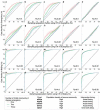This is a preprint.
Optimizing the detection of emerging infections using mobility-based spatial sampling
- PMID: 38014322
- PMCID: PMC10680910
- DOI: 10.21203/rs.3.rs-3597070/v1
Optimizing the detection of emerging infections using mobility-based spatial sampling
Update in
-
Optimizing the detection of emerging infections using mobility-based spatial sampling.Int J Appl Earth Obs Geoinf. 2024 Jul;131:103949. doi: 10.1016/j.jag.2024.103949. Int J Appl Earth Obs Geoinf. 2024. PMID: 38993519 Free PMC article.
Abstract
Background: Timely and precise detection of emerging infections is crucial for effective outbreak management and disease control. Human mobility significantly influences infection risks and transmission dynamics, and spatial sampling is a valuable tool for pinpointing potential infections in specific areas. This study explored spatial sampling methods, informed by various mobility patterns, to optimize the allocation of testing resources for detecting emerging infections.
Methods: Mobility patterns, derived from clustering point-of-interest data and travel data, were integrated into four spatial sampling approaches to detect emerging infections at the community level. To evaluate the effectiveness of the proposed mobility-based spatial sampling, we conducted analyses using actual and simulated outbreaks under different scenarios of transmissibility, intervention timing, and population density in cities.
Results: By leveraging inter-community movement data and initial case locations, the proposed case flow intensity (CFI) and case transmission intensity (CTI)-informed sampling approaches could considerably reduce the number of tests required for both actual and simulated outbreaks. Nonetheless, the prompt use of CFI and CTI within communities is imperative for effective detection, particularly for highly contagious infections in densely populated areas.
Conclusions: The mobility-based spatial sampling approach can substantially improve the efficiency of community-level testing for detecting emerging infections. It achieves this by reducing the number of individuals screened while maintaining a high accuracy rate of infection identification. It represents a cost-effective solution to optimize the deployment of testing resources, when necessary, to contain emerging infectious diseases in diverse settings.
Keywords: emerging infectious disease; human mobility; spatial sampling; testing.
Conflict of interest statement
Competing interests The authors declare that they have no competing interests.
Figures






References
Publication types
Grants and funding
LinkOut - more resources
Full Text Sources
Miscellaneous

